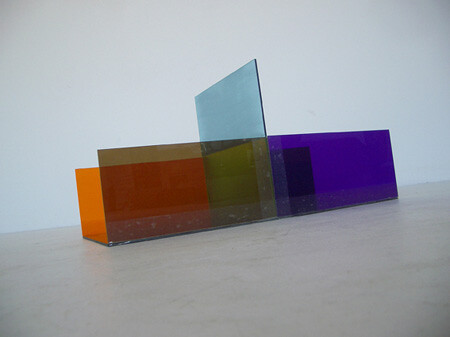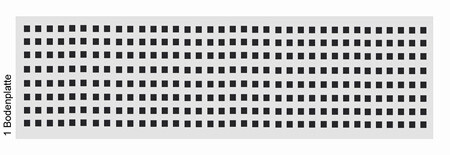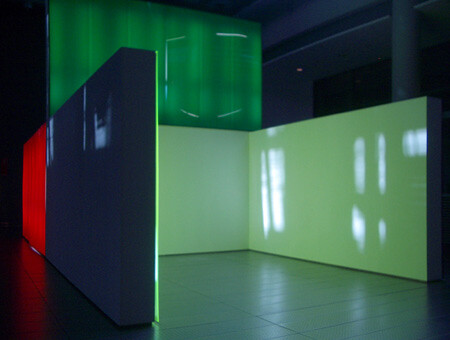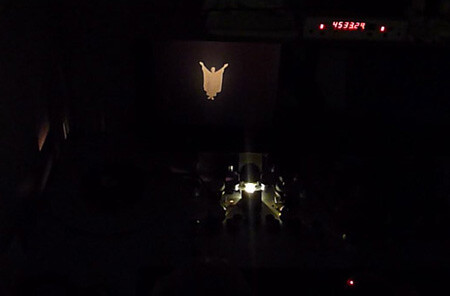A Mexico-based computer programmer coined the phrase “poor man’s expression” to illustrate a relatively simple means of developing a programming process. This reminds us of the claim made in theoretical physics that, in place of complicated test arrangements, all you need is a pencil. For Martin Ebner and me, “poor man’s expression” became just such a “pencil,” with which we designed an exhibition in May 2006 around our general ideas regarding technology, film, and conceptual art. Now, I would like to return to what originally fascinated us about this combination of words and why it became the title of our project. Secondly, the phrase might serve as a framework for a certain mode of operation.
Originally for us, the exhibition title “Poor Man’s Expression” suggested a simplified means of visualizing complex relationships. The first installment of the project was in Vienna; then it traveled to the Filmhaus Berlin, where it was exhibited in cooperation with the Arsenal Institute for Film and Video Art. The exhibition aimed to examine the relationships between film, video, technology, and art, with a particular focus on the reciprocal influences between conceptual art and experimental film. In a third development of the project, there will be a publication expanding the ideas surrounding this concept.1
But the phrase “poor man’s expression” also signifies, for me, an idea for an ongoing development of projects and ideas, a history of minor stories that began for me twenty years ago with the Botschaft collective.2 A certain moment of self-organization and independence, a taking-of-ground within a limited period of time, was explored by a number of self-organized spaces in Berlin throughout the 1990s, and as many of those spaces were later institutionalized, this era of activities and practices deserves to be revisited. By interpreting “Poor Man’s Expression” as a possible development of those strategies, I want to review also the ideas employed then and propose a reciprocal interpretation.


The model for the architecture of “Poor Man’s Expression.” Photo: Martin Ebner.
DIY Battleground
The title “Poor Man’s Expression” suggests a do-it-yourself aspect. For some, DIY is an attitude as well as a punk-related ideology, one whose adaptability to cultural practices has been analyzed by theorists—and yet it appears to remain somehow “homemade,” especially against the backdrop of the art boom in recent years, as witnessed by events like the Miami Basel Beach fair. The rapid selling-out of punk has lead many to lose interest in its ideals, but that is the wrong impulse. It has always been about creating a basis instead of accepting one, however tempting the offer might be. In contrast, the ability to create one’s own environment—to determine one’s own context as much as possible, even if it can never be complete or wholly autonomous—is luxury. Perhaps this is an illusion, a distorted mirror image. Ideally, however, freely chosen conditions allow for a clear view of the exhibition/idea/image/film without obstructions that might ruin the concept.
“Poor Man’s Expression” did not begin in a specific location, but the context was given at an early stage: the experimental films in the archive of Arsenal cinema, founded in 1970 by the Friends of the German Cinematheque, giving insights into a century-long film history.3 We would have relocated this collection of extraordinary films to display our concept of entangled, contemporary artists—a group that was selected not for use of moving image, but rather for a conceptual approach that combined formal experiment and “minimal” means with a certain narration and most often political awareness. However, when visiting different institutions in Berlin we soon shied away from places that meant nothing to us, from rooms we could not define, from places that were already the canvas for something else—so culturally present were their white walls. We went away without even talking to anyone and turned to the Arsenal, a sort of foreign body in the vicinity of the Sony Center and its creepy corporate architecture—a choice recalling the improbable spaces that were turned into exhibition venues, makeshift cinemas, and bars two decades ago; this time, instead of being off-site, we would return to the scene of the crime.
At the glass tower of the Sony Center, whose perforated floors are surrounded by metal-plated wall coverings, up through which shoot what were once Europe’s fastest elevators, being self-determined did mean using the blinder chairs from Peter Kubelka’s Invisible Cinema, as various debates about dissolving the cinema space into the museum would suggest. Rather, this was a place to start a debate on a field where mainstream cinema meets the railway employee, where the Sony image-production machine meets Dunkin’ Donuts, where Japanophile mall architecture meets the experimental film archive of the Arsenal.


A perforated baseplate from Sony Center. Computer rendering during preparation phase for “Poor Man’s Expression”.
In his contribution to the Poor Man’s Expression volume, Anselm Franke uses the term “battleground”—a surprising metaphor in it’s reference to war—to describe as the background of this situation “the impossibility to take the interface between subject and technology into consideration.” He locates this ground where “the omnipresent practice of mediality, which finds no expression, seeks a symptomatic arena, which constantly restages the structurally repetitive conflict.”4 In this moment, “poor man’s expression” turns into a Kampfbegriff (fighting words) in the battle between mediatization through the “image-production machine,” and the location of the self. Soft fighting words though, and symbolic ones, since a translation into reality—as poverty—is neither legitimate nor desirable, as it would only transpose the “poor” computer-poetry onto a social level—a move that does not work on our playing field …
An Imperfect Process
In this context, two things keep coming up: Julio García Espinosa’s “cine imperfecto” (imperfect cinema) and Franz Kafka’s “minor literature,” and their contemporary applications. Espinosa’s text “Por un cine imperfecto” (For an Imperfect Cinema) is one of the most important texts of Third Cinema.5 We could imagine adapting to the art world its assumption that “the perfect cinema—technically and artistically masterful—is almost always reactionary cinema.” However, we are primarily interested in its anti-elitist approach and its focus on process over outcomes and analysis. When referring to the late 1960s and early 1970s, today’s art-cinema practitioners rarely acknowledge that experimental film and conceptual art developed in parallel with political, emancipatory, and anti-colonial projects.6 We now assume a correlation between political awareness and artists’ formal innovation, and it is via this assumption that we want to engage the term “poor” to establish a schema in contrast to on the one hand mass entertainment, on the other to the preciosity of some current art production that happily appropriates values of production management and artistic omnipotence.
It is well known that reduced means can result from economic necessity. Though 16 mm film was introduced in 1923, it became recognized as an innovation of the 1940s, as the need for lower production costs and smaller cameras around that time made the format appealing to many people.7 Those who could not afford film at all used the carousel projection of slides to create their “films.” Only later did 8 mm and video formats become available (and let’s not ignore the fact that most filmmakers initially despised the video image). The “poor means” of the experimental filmmaker—as well as, in a distant relation, those of Espinosa—further expanded the field of material possibilities for production, invitation, and inclusion. For our project, this included YouTube, UbuWeb, and other open-source database archives and image resources, which constitute poor man’s expressions par excellence. It is symptomatic that today the 16 mm projector has found its luxurious home in art centers and galleries, while YouTube has become the place to watch an interview with Hollis Frampton.
A Minor Exhibition
Researching poor means of production leads us to the narration of little stories, and to their interpretations. Michael Eng adapted Kafka’s “minor literature” for another film/art project I worked on:
A minor cinema is not another, alternative form of cinema, nor is it a fixed state of the image. It is a cine-pragmatics that exploits “official, domesticated ways of seeing” by queering the very conditions of perception and by producing an exiled relation between images.8
While rediscovering our project consensus, Martin and I agreed that a fundamentally more complex, and perhaps sociocultural, understanding of the development of art was necessary to expand the conventional hero narrative: a simultaneous development of and exchange between different protagonists, as Lucy Lippard described it apropos of conceptual art in Six Years.9 Michael Eng’s definition of minor cinema supports this:
Whereas a major cinema might still consider a film or a work to be the reflection of the agency of an intentionality of a director or auteur, that is to say, a reflection of mastery … a minor cinema collapses such a conception out of hand, eschewing the model of a unified mind presiding over a unified object in favor of a certain schizophrenia arising out of a confrontation with the sheer materiality of the image. Whereas a major cinema insists on a general homogeneity of the production, reception, and representation of images—a cinematic common sense—a minor cinema actualizes dormant potentialities of the image in order to make way for the heterogenisation and othering of a mad cinematic space.10


The (still empty) architecture of “Poor Man’s Expression”. Photo: Martin Ebner.
When developing the exhibition architecture for “Poor Man’s Expression” into a double room in the open space of the Arsenal foyer, we thought of the technology of stereoscopy—which uses a compensating mechanism in the eye to dissolve the technical illusion—as what Axel John Wieder called “an attempt to dispossess the contingency of thematic configurations of their sometimes so obvious-seeming logic, and instead to keep visible the interdependence of theses and historical developments to less objective factors.”11 This “mad space” within the Sony Center displayed an ambiguous relation to the Arsenal space—a dichotomy between entertainment giant and auteur cinema. Each artist in the exhibition placed one work next to a second work, designating a sort of heterotopic space of the image in our exhibition, what Michael Eng called “the advent of a shizocinema.”12
Returning to the metaphor of battle, when tackling terms like “major” and “minor,” one should bear in mind that, as Branden Joseph puts it, the major
is instituted in … the interests of erecting or maintaining a hierarchical power. This is true even if that power is an avowedly revolutionary one… . In contrast, the “minor” is not the qualitatively or quantitatively inferior, but what is marked by an irreducible or uncontainable difference. It is not a subcategory or subsystem in a conventional sense, but what Deleuze and Guattari call at one point an “outsystem” (hors-système).13
“Poor Man’s Expression”—as an operating principle—used “minor expression” to situate itself outside the tradition of “grand battles” and in contrast to the arrogance and exclusion of grand narratives.
The Living Archive
The archive of the Arsenal Institute came into being through the programming of the Arsenal cinema, soon contained films shown in the Berlinale Forum section of the Berlin International Film Festival, and has been continually expanded through its staff’s interest in collecting excellent films. It sees itself as making formal experiments, political avant-garde films, and films from marginal areas of the world visible—a virtual “outsystem” of official historiography. The very diverse contributors to the archive share an understanding of film characterized by the mutual entanglement of aesthetics and politics. Just as it is impossible to built up such an archive as an individual, neither can it be built by a single collector. As a side effect of such strategies, many filmmakers and artists contributed their works as a gesture of friendship and as a sign of solidarity with the Arsenal archive. This has been made possible in part due to the informal copyright status attached to many of the works.


Arsenal archive editing table, with filmstill from Harry Smith: “Mirror Animations”. Photo: Martin Ebner.
Next to the permanent use by researchers and curators, it is the informal status of those works that constantly reaffirm the “living” nature of the Archive. In contrast, when a film’s author is deceased, a number of legal issues arise, and in some cases a film cannot be shown for this reason, which renders it effectively non-existent.14 Seeing the Archive through the eyes of the contributing artists allowed us a very subjective view within “Poor Man’s Expression,” with a collaborative selection process that came close to appropriating the historic works altogether. For eight successive evenings during the exhibition, the selected experimental films were confronted with all kinds of additional programming contributed by the artists: Kim Jung Il’s various film projects, Dziga Vertov’s newsreels, a musically accompanied reading, and a presentation on steganography. The atypical quality of this process was underlined by projecting the films outside the cinema space, onto our architecture, for a different means of addressing the audience—a “deviant” usage, resulting in a very lively space, a truly living archive.
In Light of Diversity
In developing the concept for “Poor Man’s Expression,” Martin Ebner and I worked in close collaboration with the artists, a strategy based partly on our experiences of self-organization during the 1990s in Berlin, but also indebted to a tradition of artist-organized exhibitions that have taken place throughout art history, particularly in periods of open experimentation such as the 1960s. In light of our already diverse group of participants, we defined our mode of cooperation as a means of expanding the landscape of possibilities for reinterpreting the curatorial principle altogether.
These considerations run parallel to the realm of capabilities I discussed earlier as a means of minimizing external influences and maximizing the probable definitions available to a hors-système. It might be a short-lived system: Botschaft, the group in which I experienced the potential of such strategies, laid claim to earlier unknown locations, the exploration of the local as a basis for artistic activities on a global level, the social within this process, the need for a political agenda, the demand for surprising concepts. It was a predecessor to aforementioned curatorial experiments, Our ways of working could be established within a limited period of time and through the constructive use of empty real estate, and we decided to close down after six years. When those tactics were instrumentalized for commercial development, and some spaces institutionalized, this era of activities and practices needed to be abandoned. But the principles of such “outsystems” ask for reinterpretations. “Poor Man’s Expression” is one of those reinterpretations.
More on Botschaft can be found in the text of Natascha Sadr Haghighian in this issue, see →. There is not much information online about the Botschaft (Berlin, 1990–1996), as the group actively rejected being historicized. Brief profiles can be found here: → and here, the beginning of an upcoming source archive: →.
In 2009 Freunde der Deutschen Kinemathek (Friends of the German Cinematheque) was renamed Arsenal – Institute of Film and Video Art. See their website: →.
Anselm Franke, “Tilting in the Image-Space of Social and Technological Worlds,” in Poor Man’s Expression, ed. Martin Ebner and Florian Zeyfang (Berlin: Sternberg Press, forthcoming).
Julio García Espinosa’s Por un cine imperfecto first appeared in Cine cubano 66/67 (1969), then, in an incomplete English translation, in Afterimage 3 (Summer 1971), and finally in a new translation by Julianne Burton in Jump Cut, no. 20 (1979), available at →. See also Hito Steyerl, “In Defense of the Poor Image,” in e-flux journal, no. 10, →.
Volker Pantenburg recently underscored this in a lecture, “Experimentalfilm und Kunsträume,” delivered at the conference “Entgrenzung des Kinos – Grenzen des Films” (Cinema without Walls – Borderlands of Film) at ICI Berlin, April 23, 2010. The text is due to be published.
In Eastern Europe 16 mm was less available, so most experimental films were done through film academies on 35 mm film.
Michael Eng, “Numéro un et Numéro Deux: It was Outside, The Rejection of the Image,” in I said I love. That is the promise. The Tvideo Politics of Jean-Luc Godard, ed. Gareth James and Florian Zeyfang, OE Critical Readers in Visual Cultures no. 4 (Berlin: b_books, 2003), 291.
Lucy Lippard, Six Years: The Dematerialization of the Art Object from 1966 to 1972 (Berkeley: University of California Press, 1997).
Eng, “Numéro un et Numéro Deux,” 291.
Axel John Wieder, “To Be Lit and to Illuminate,” in Poor Man’s Expression, l.
Eng, “Numéro un et Numéro Deux,” 291.
Branden Joseph, “What Is a Minor History?” in Poor Man’s Expression, l.
As in the recent example of Jack Smith and Bruce Conner, the administration aims at achieving an understanding with testamentary executors and copyright owners to show these films.
Translated from the German by Michael Lattek.